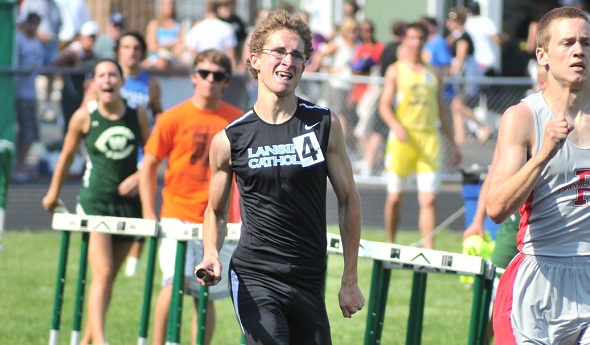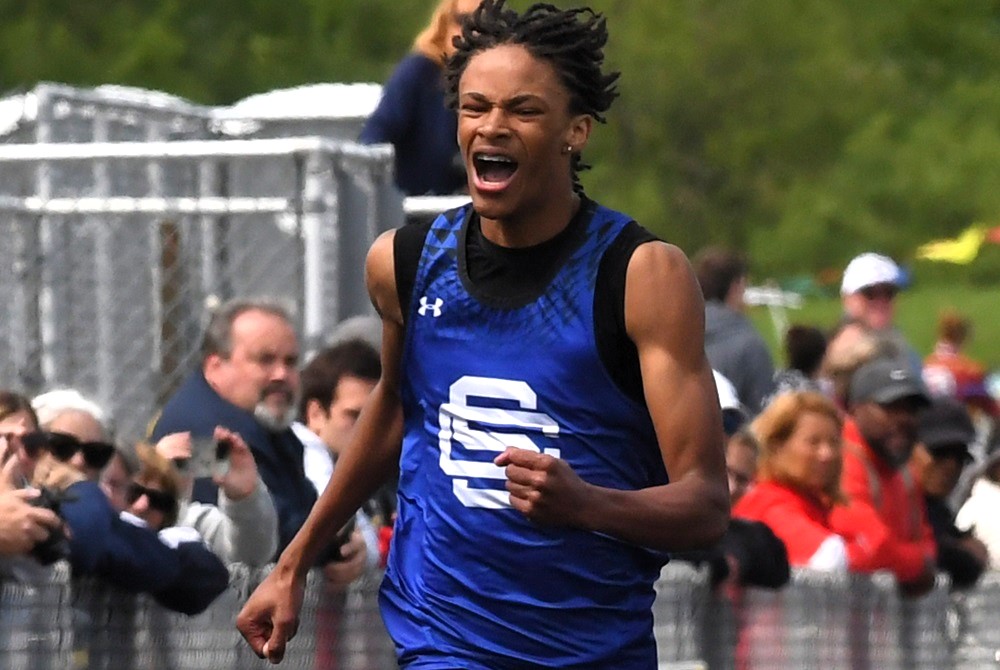
Zingsheim's Story an Award-Winner
May 31, 2012
By Geoff Kimmerly
Second Half editor
Zack Zingsheim’s career highlight is an easy pick.
It was just a few months ago, at Michigan International Speedway, when he stunned even himself by winning the MHSAA Division 3 cross country championship.
He can describe in vivid detail being the last to come out of the chute at the finish, looking into the grandstand and telling himself to always remember the moment. He can see again his teammates further down the chute, chanting his name. The goose bumps he felt. How they jumped the fence, lifted him to their shoulders and carried him off the course.
It was the greatest day he could remember. And it ended with a pie in the face.
“I remember how surreal the moment was,” he said. “Since I was a little kid, I thought it would be so cool to win the state meet for cross country; the atmosphere is so amazing.”
Nearly as amazing is he doesn’t remember the flavor of the pie.
Zingsheim tells a story with the best of them – thanks in part to a keen photographic memory and attention to detail.
But he gets a Second Half High 5 this week because of his status as one of the state’s top high school runners – and what a tale he’s spun over the last year.
Zingsheim has the top-seeded Division 3 time in the 800 meters (1:55.30) heading into Saturday’s Finals at Comstock High School, and also runs on the top-seeded 800, 1,600 and 3,200 relays. He and his teammates won the 800 relay at last season’s Finals, and he has or is part of school records in all four of those races, plus the 400. He’s also the fastest in Cougars cross country history.
Another of his favorite stories to tell explains why.
Diamond in the rough
He remembers seeing the Corunna baseball diamond in the distance. That’s key to this story.
Zingsheim was a freshman in 2009, running the second leg of the 800 relay, and had just taken the baton. His right hip had been feeling tight and then painful over the previous couple of weeks, but he felt great at that point as he glanced ahead and saw the baseball field.
The next step, he felt like he got hit with a baseball square in the right hip. But there was no baseball.
He tried to bring the leg forward, and couldn’t. He dragged his leg the next 100 meters to complete his handoff, and then collapsed.
Zingsheim did see a “flabby piece of bone just laying there.” He started crying. His parents immediately drove him to the hospital as he screamed the lyrics to whatever was on the radio to try to forget the pain. (And yes, he remembered one off the songs: “Boom Boom Pow” by the Black Eyed Peas.)
The flexor muscle that connected his hamstring to his pelvis had torn and taken the top of that part of his pelvic bone with it.
Next came months of therapy and changes. He’d started on the freshman basketball team, but decided to stop that sport and focus on running. Still, he couldn’t get in shape that summer because he couldn’t put in the miles, and his sophomore cross country season wasn’t what he’d wanted – until he ran a personal best late in the season and got a needed confidence boost.
“There’s something so special about being able to run so hard and seeing hard work come to fruition on the course or the track,” Zingsheim said. “And especially, seeing how far I had to come. I wanted to see what kind of runner I could become if I put all that work in.”
His 1,600 relay finished eighth at the 2010 Division 3 Finals, another turning point. A year later, Lansing Catholic coach Tim Simpson needed a fill-in on the 800 relay. The date was April 13, 2011 – a day shy of two years since he’d suffered the pelvic break. “I’ve never been so nervous for another race,” he said. But the Cougars set a school record, and he’s been on that relay since.
A long road traveled
“He’s come a long way, but he’s always had that ability,” Simpson said. “He ran 50-70 miles a week during the summer. He reads about the top runners, follows it, so he know what they’re doing, what you’re supposed to do if you’re going to be good.”
There’s always an eye on the details; Zingsheim’s got a reputation among his classmates as the guy who always is last to turn in his tests. He gets done quickly, but spends the rest of the period double and triple-checking his answers to make sure everything is right.
There are plenty of other stories, of course. Like how he and his talented classmates – Lansing Catholic’s senior boys also played in the Division 5 Football Final in the fall – split up during middle school into football teams that stayed the same for months and turned into fierce rivalries. (He played receiver.)
He’s earned the story-teller role in his family too; at gatherings he’s often the go-to guy for a “quirky” or “goofy” family tale.
But the stories he’ll be most proud to be part of are those that get passed down to Lansing Catholic runners after him.
Zingsheim was in first grade when his brother Brandon was a senior on the cross country and track teams and began the Cougars’ tradition of saying a “Hail Mary” and chanting “Hey Cougars, what we going to do?” Zack is among those who now lead that rally.
Lansing Catholic had outstanding runners before Zingsheim. But with him and a strong group of individuals including distance seniors Jimmy Hicks (who will walk-on at the University of Georgia), Austin Winter and Joe Marrah, they could cap their careers with the team’s first MHSAA championship.
“What I really wanted to do by the time my tenure was done was lay a foundation. Build the program; do things the right way,” Zingsheim said. “I wanted to teach guys what it means to be an LCC runner.
“The last four years, we’ve really been able to build that program. … And I’m so excited to see where the program is going the next couple of years.”
Click to read more about Zingsheim's inspirations and aspirations.
PHOTO: Lansing Catholic's Zack Zingsheim was part of the championship-winning 800 relay at last season's Division 3 Final.

Performance of the Week: Southfield Christian's Brock Morris
June 5, 2025
 Brock Morris ♦ Southfield Christian
Brock Morris ♦ Southfield Christian
Senior ♦ Track & Field
Morris finished an individually-phenomenal day at Saturday's Lower Peninsula Division 4 Finals by helping his teammates make school history. With Southfield Christian trailing leader Kalamazoo Hackett Catholic Prep by three points heading into the final event of the day, Morris anchored the Eagles' 1,600 relay and crossed the finish line first – which, combined with Hackett's third-place finish in the race, gave Morris and his teammates their school's first Finals team championship in track & field by one point.
That victory capped a day that also saw Morris win the 200 and 400-meter open races and run on the winning 800 relay as well. Morris was part of school records in all four of those races this season and the 400 relay as well; the 1,600 relay time of 3:24.36 on Saturday lowered that school record and also included Dylan Taylor-Wilkerson, Robert Brown and Jadon Staten. Morris also ran cross country and played point guard on the boys basketball team. He will study at University of Michigan, majoring in biology, health and society on a pre-medical track.
@mhsaasports 🏃♂️POW: Brock Morris #southfieldchristian #track #finals #winner #1600relay #anchor #part1 #highschoolsports #tiktalk #interview #performanceoftheweek #mistudentaid #fyp #MHSAA ♬ original sound - MHSAA
@mhsaasports 🏃♂️POW: Brock Morris #instagram #chocolatemilk #hidden #talent #emoji #part2 #performanceoftheweek #mistudentaid #fyp #MHSAA ♬ Monkeys Spinning Monkeys - Kevin MacLeod & Kevin The Monkey
Follow the MHSAA on TikTok.
MHSAA.com's "Performance of the Week" features are powered by MI Student Aid, a division within the Department of Lifelong Education, Advancement, and Potential (MiLEAP). MI Student Aid encourages students to pursue postsecondary education by providing access to student financial resources and information. MI Student Aid administers the state’s 529 college savings programs (MET/MESP), as well as scholarship and grant programs that help make college Accessible, Affordable and Attainable for you. Connect with MI Student Aid at www.michigan.gov/mistudentaid and find more information on Facebook and Twitter @mistudentaid.
Previous 2024-25 honorees
May 30: Chloe Qin, Bloomfield Hills Cranbrook Kingswood tennis - Report
May 23: Drew Goik, Bay City Western golf - Report
May 15: Sydney Kuhn, Saginaw Swan Valley track & field - Report
May 8: Ryan Bosch, Fruitport baseball - Report
May 1: Jackson Lam, Kalamazoo Loy Norrix track & field - Report
April 25: Isabelle Horvath, Bangor softball - Report
April 18: Presley Jones, Sterling Heights Stevenson soccer - Report
April 11: Olivia Jasniewicz, Troy soccer - Report
March 27: Katie Spicer, Fowler basketball - Report
March 21: Moses & Markus Blackwell; Warren Lincoln basketball - Report
March 13: Keyshawn Summerville, Lansing Sexton basketball - Report
March 6: Maggie Buurma, Fowlerville wrestling - Report
Feb. 28: Maren Studt, Pontiac Notre Dame Prep skiing - Report
Feb. 21: Olive Krueger, Marquette swimming - Report
Feb. 14: Hunter Lemmon, Fraser swimming - Report
Feb. 7: Aubrey Hillard, Rochester competitive cheer - Report
Jan. 31: Wyatt Spalo, Reed City wrestling - Report
Jan. 24: Olivia Flynn, Harbor Springs basketball - Report
Jan. 17: Levi Rozema, Holland Christian swimming - Report
Jan. 10: McRecco McFadden, Burton Bentley basketball - Report
Dec. 18: Nash Leonard, Bay City Western hockey - Report
Dec. 11: Blake Cosby, Dundee wrestling - Report
Dec. 4: Keaton Hendricks, Zeeland West football - Report
Nov. 29: Kate Simon, East Grand Rapids swimming - Report
Nov. 22: Ella Kokaly, Essexville Garber volleyball - Report
Nov. 15: Caroline Bryan, Grosse Pointe South swimming - Report
Nov. 8: Kaylie Livingston, Whitmore Lake cross country - Report
Oct. 25: Oliver Caldwell, Grand Rapids West Catholic tennis - Report
Oct. 18: Alex Graham, Detroit Cass Tech football - Report
Oct. 11: Victoria Garces, Midland Dow cross country - Report
Oct. 4: Asher Clark, Bay City John Glenn soccer - Report
Sept. 26: Campbell Flynn, Farmington Hills Mercy volleyball - Report
Sept. 19: TJ Hansen, Freeland cross country - Report
Sept. 12: Jordan Peters, Grayling soccer - Report
Sept. 6: Gabe Litzner, Sault Ste. Marie cross country - Report
Aug. 30: Grace Slocum, Traverse City St. Francis golf - Report
(Photo by RunMichigan.com.)

